08 - Personnel Protocols
Created by Commander Morgan Tarin on 08 Aug 2023 @ 7:58am
Table of Contents:
- 8.1 Uniform Code of Appearance
- 8.2 Duty Watches
- 8.3 Duty Teams
- 8.4 Security Clearances
- 8.5 Dedication & Ceremonial Plaques
8.1 Uniform Code of Appearance
- All personnel must maintain a high standard of dress and appearance. Uniforms will fit properly and personnel must keep uniforms clean and serviceable and press them as necessary. Starfleet personnel must project a professional image that leaves no doubt that they live by a common standard and are responsible to Starfleet order and discipline. Crewmen will ensure that articles carried in pockets do not protrude from the pocket or present a bulky appearance.
- Personnel will not wear electronic devices on the uniform when the commander determines such wear is inappropriate, such as in formation, or during parades or ceremonies. Personnel will not wear items or devices on the uniform when not performing required duties.
- While in uniform, personnel will not place their hands in their pockets, except momentarily to place or retrieve objects. Personnel will keep uniforms buttoned, zipped, and snapped. They will ensure metallic devices such as insignias, rank pips, belt buckles, and belt tips are free of scratches and corrosion and are in proper luster or remain properly subdued, as applicable; and that all medals and ribbons are clean and not frayed. Personnel will keep shoes and boots cleaned and shined. Personnel will replace their insignia/commbadge when it becomes unserviceable or no longer conforms to standards.
- Although most uniform items are recyclable and replicated with a permanent-press finish, personnel may need to occasionally press these items themselves to maintain a neat, professional appearance. However, before pressing uniform items, personnel should read and comply with care instruction labels attached to the items.
Figure 8.1.1 - USS Galileo uniforms circa 2392
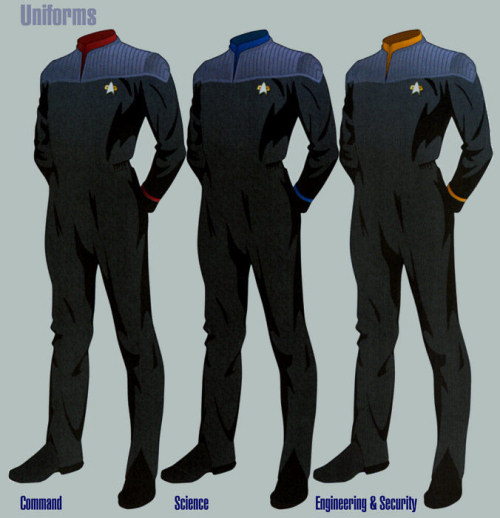
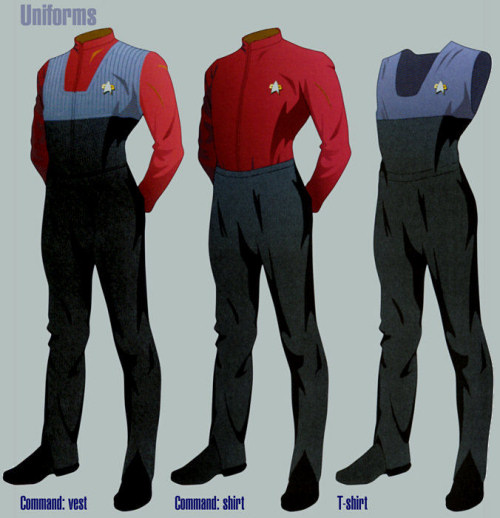
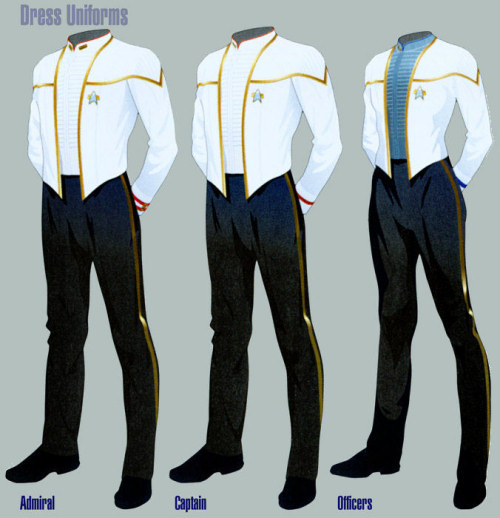
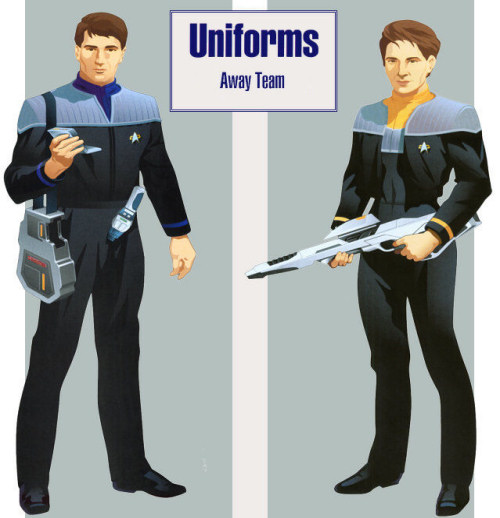
8.2 Duty Watches
The standard Starfleet watch system aboard USS Galileo is split into a series of rotating duty watches similar to those found aboard other Starfleet and civilian vessels. On board the starship, crew members are permanently assigned to one of three teams. At the discretion of the First Officer, senior officers, junior officers and department heads are equally distributed between these teams in order to provide adequate supervision and departmental competency at all hours of the day.
There are three eight-hour duty watches per 24-hour cycle meaning the three-team system effectively allows the vessel to operate on a 24-hour work day. This is done to maximize operational efficiency, meal and recreational times, and sleep patterns. Watch teams aboard Galileo operate on a "14-on, 10-off" schedule with the first eight hours devoted to the duty shift. The next six hours are used for administration, maintenance and cleaning, and the final ten hours are typically used for entertainment, physical training and rest. The precise timing of each duty shift also takes into account common meal times and allows for incoming teams to eat before standing watch while the outgoing team relieved of watch is able to obtain a meal immediately following their shift.
The three watch teams operate on a standard rotation throughout Alpha, Beta and Gamma shifts. Because of the nature of the 14-hour work day, each team will only stand watch once within the 24-hour cycle.
| WEEK 1 | WEEK 2 | WEEK 3 | |
| Alpha Shift (0700-1500) |
Team 1 | Team 2 | Team 3 |
| Beta Shift (1500-2300) |
Team 2 | Team 3 | Team 1 |
| Gamma Shift (2300-0700) |
Team 3 | Team 1 | Team 2 |
ALPHA SHIFT (0700-1500 HRS)
Commonly referred to as the "Morning Watch", Alpha shift takes place in the morning between the hours of 0700 and 1500. Personnel standing watch during Alpha shift are able to visit the mess hall both before their shift and afterwards for a fresh-cooked meal, or - if preferred - a replicated breakfast or lunch. Upon arriving at their duty stations, Alpha shift personnel are quickly debriefed by Gamma shift personnel regarding ship-wide activities over the previous eight hours and take note of any potential issues which might need to be resolved during their shift. The officer in command (OIC) for Alpha shift is usually the senior-most command staff member or department head on duty, although this person may or may not be present on the bridge. In the absence of the OIC's presence on the bridge, the senior-most bridge officer will assume operational control of the command center.
BETA SHIFT (1500-2300 HRS)
Beta shift, the "Night Watch", begins mid-afternoon and runs through the late evening to 2300 hours. Personnel standing watch during Beta shift are able to obtain a fresh or replicated lunch from the dining facilities directly before their watch, and at the end of the period, are able to visit the lounge for the final hours of dinner and entertainment services. Upon arriving at their duty stations, Beta shift personnel are quickly debriefed by Alpha shift personnel regarding ship-wide activities over the previous eight hours and take note of any potential issues which might need to be resolved during their shift. The officer in command (OIC) for Beta shift is usually the senior-most command staff member or department head on duty, although this person may or may not be present on the bridge. In the absence of the OIC's presence on the bridge, the senior-most bridge officer will assume operational control of the command center.
GAMMA SHIFT (2300-0700 HRS)
Gamma shift is affectionately known in contemporary navies as the "Mid Watch", the period that occurs in the heart of the night and early morning before Alpha shift comes on watch. It begins at 2300 and ends at 0700. Gamma shift personnel can visit Callisto Bar/Lounge before their shift for a fresh-cooked meal, and at the end of their shift, are able to go to the mess hall for a properly-cooked breakfast. Upon arriving at their duty stations, Gamma shift personnel are quickly debriefed by Beta shift personnel regarding ship-wide activities over the previous eight hours and take note of any potential issues which might need to be resolved during their shift. The officer in command (OIC) for Gamma shift is usually the senior-most command staff member or department head on duty, although this person may or may not be present on the bridge. In the absence of the OIC's presence on the bridge, the senior-most bridge officer will assume operational control of the command center.
8.3 Duty Teams
While duty watches (Alpha shift, Beta shift, etc.) are fixed in schedule and always occur at the same time every day, the personnel team assigned to each watch constantly rotates on a three-week cycle. As such, crew members aboard USS Galileo are not assigned to permanent duty watches, but rather to permanent duty teams. Each duty team consists of an Officer-in-Command (OIC) as well as permanently-assigned bridge crew personnel. The breakdown of duty team personnel is as follows:
View Galileo's
Full Duty Assignments
8.4 Security Clearances
Security clearance or security verification is a level of authority given to an officer based on rank, status and position. Computers then identify the individual by the entry of their vocal or alpha-numerical authorization code. Alternatively, specially programmed isolinear rods entered into the computer can also allow various levels of security clearance. Different levels of clearance are assigned to members of the ship by the command staff, and may vary due to position, rank and current mission.
LEVEL 1
- Rank(s): Civilian
- Data Access: Level 1 (Restricted)
- Privileges: Allows basic access to some areas aboard Galileo, as well as personnel and official logs. Allows basic, limited and restricted access to Starfleet records and data files.
LEVEL 2
- Rank(s): E-xC (Cadet); E-1 to E-3 (Junior Enlisted)
- Data Access: Level 1
- Privileges: Allows full operational access to most areas aboard Galileo, as well as personnel and official logs. Allows basic, limited and restricted access to Starfleet records and data files.
LEVEL 3
- Rank(s): E-4 to E-9 (Noncommissioned Officer)
- Data Access: Level 2
- Privileges: Allows full operational access to most areas aboard Galileo, as well as personnel and official logs. Allows access to weapons locker for Starfleet personnel. Also allows limited access to Starfleet records and data files.
LEVEL 4
- Rank(s): CWO-2 to CWO-4 (Chief Warrant Officer); O-1 (Ensign)
- Data Access: Level 2
- Privileges: Allows full operational access to most areas aboard Galileo, as well as personnel and official logs. Allows access to weapons lockers for Starfleet personnel, as well as access to tactical data and communications systems. Level 4 is also the minimum security clearance for all Starfleet intelligence officers, and allows limited access to Starfleet records and data files.
LEVEL 5
- Rank(s): O-2 (Lieutenant Junior Grade)
- Data Access: Level 3
- Privileges: Allows full operational access to most areas aboard Galileo, as well as personnel and official logs. Allows access to weapons lockers for Starfleet personnel, as well as access to tactical, operations, flight control, and communications systems. Level 5 clearance permits the officer basic operational authority in certain situations. Also allows access to most Starfleet records and data files.
LEVEL 6
- Rank(s): O-3 (Lieutenant)
- Data Access: Level 3
- Privileges: Allows full operational access to most areas aboard Galileo, as well as personnel and official logs. Allows access to weapons lockers for Starfleet personnel, as well as access to tactical, operations, flight control, and communications systems. Level 6 clearance permits the officer limited operational authority in certain situations. Also allows access to most Starfleet records and data files.
LEVEL 7
- Rank(s): O-4 (Lieutenant Commander)
- Data Access: Level 3
- Privileges: Allows full operational access to all areas aboard Galileo, as well as personnel and official logs. Allows access to weapons lockers for Starfleet and non-Starfleet personnel, including the armory, as well as access to tactical, operations, flight control, communications, and command systems. In addition, full access is granted to the ship's shuttlebay and support craft. Level 7 clearance permits the officer full operational authority in certain situations. Also allows access to most Starfleet records and data files.
LEVEL 8
- Rank(s): O-5 (Commander)
- Data Access: Level 4
- Privileges: Allows full operational access to all areas aboard Galileo, as well as personnel and official logs. Allows access to weapons lockers for Starfleet and non-Starfleet personnel, including the armory, as well as access to tactical, operations, flight control, communications, and command systems. In addition, full access is granted to the ship's shuttlebay and support craft. Level 8 clearance permits the officer full operational authority in certain situations. Also allows access to all Starfleet records and data files, unless classified by a higher authority.
LEVEL 9
- Rank(s): O-4 to O-6 (Executive Officer)
- Data Access: Level 4
- Privileges: Allows full operational access to all areas aboard Galileo, as well as personnel and official logs. Allows access to weapons lockers for Starfleet and non-Starfleet personnel, including the armory, as well as access to tactical, operations, flight control, communications, and command systems. In addition, full access is granted to the ship's shuttlebay and support craft. Level 9 clearance is reserved specifically for the ship's executive officer, regardless of rank, and gives s/he full operational authority in many situations. Also allows access to all Starfleet records and data files, unless classified by a higher authority.
LEVEL 10
- Rank(s): O-5 to O-11 (Commanding Officer)
- Data Access: Level 4/5
- Privileges: Allows full operational access to all areas aboard Galileo, as well as personnel and official logs. Allows access to weapons lockers for Starfleet and non-Starfleet personnel, including the armory, as well as access to tactical, operations, flight control, communications, and command systems. In addition, full access is granted to the ship's shuttlebay and support craft. Level 10 clearance is reserved specifically for the ship's commanding officer, regardless of rank, and gives s/he full operational authority of the ship at all times. It is required to access the Omega One data file, which contains information on the Omega Directive. Also allows access to all Starfleet records and data files, unless classified by a higher authority. Depending on the commanding officer's rank, Level 5 (the highest) data access privileges may be assigned.
8.5 Dedication and Ceremonial Plaques
Figure 8.5.1 - USS Galileo NCC-80010 dedication plaque circa 2389
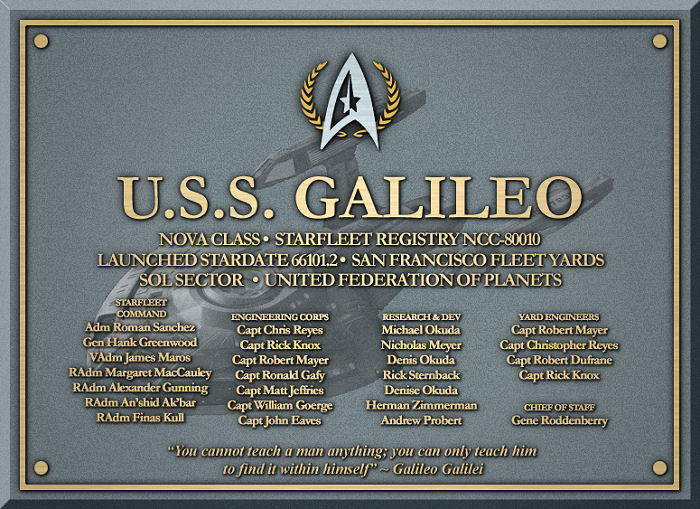
Figure 8.5.2 - USS Galileo NCC-80010 ceremonial plaque circa 2389
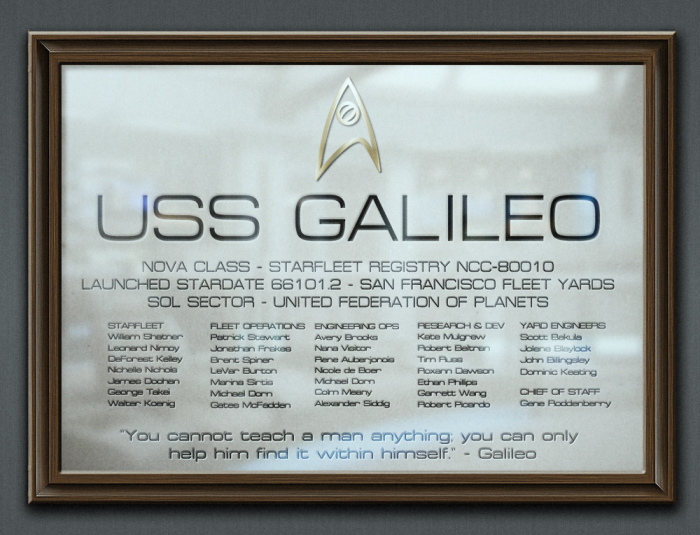
Categories: Gameplay Manual

